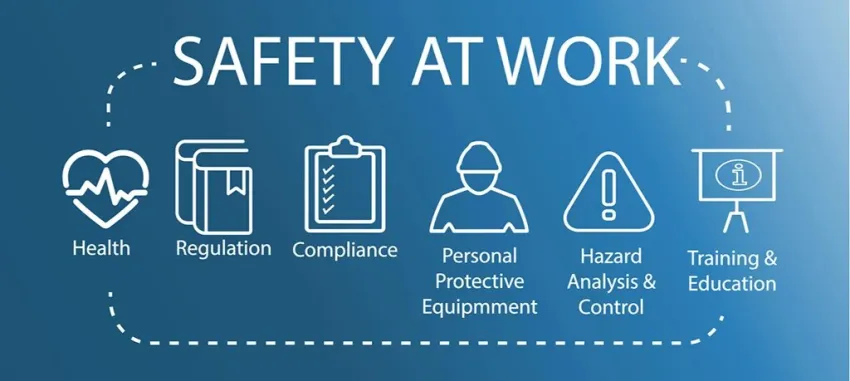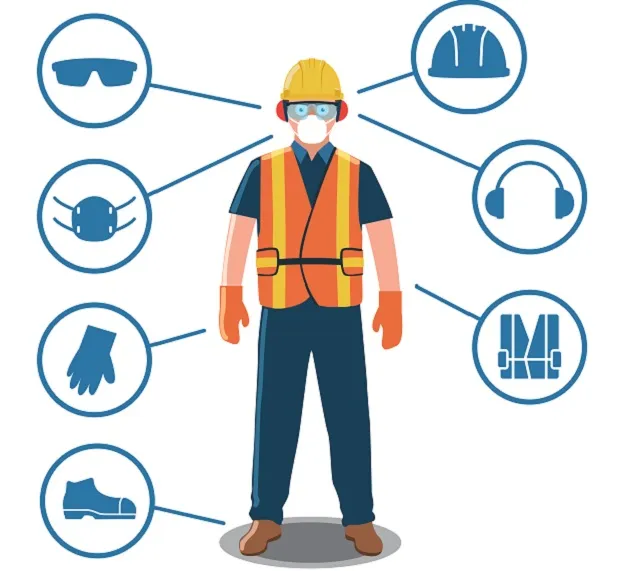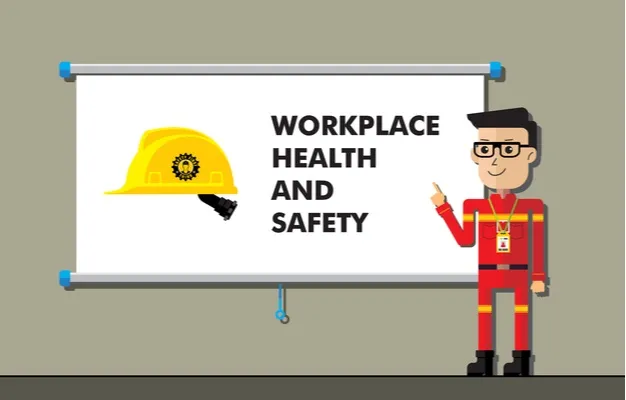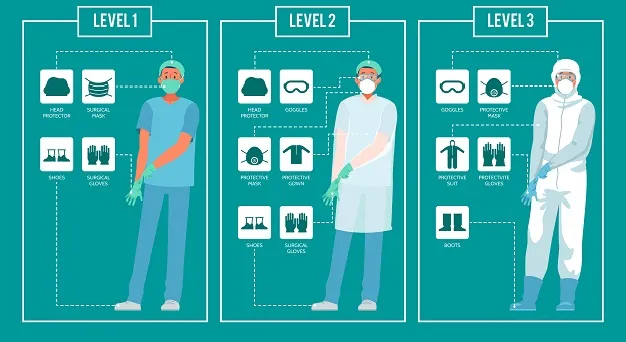
Menu

Menu

Ensuring a work environment that protects employee health and safety is both a legal and moral obligation for organizations. While some settings pose higher risks—such as exposure to contamination, heavy equipment use, or working at height—every workplace must comply with relevant legislation.
To foster a culture of safety, organizations should conduct regular training and risk assessments, enabling employees to recognize and respond to hazards effectively. Open communication about safety concerns is also crucial.
Ultimately, prioritizing health and safety not only protects employees but also boosts productivity and morale, fostering trust and loyalty within the organization.
The impact of the COVID-19 pandemic has significantly raised awareness of the importance of safety in the workplace. As a result, increased attention to health and safety is likely to influence job choices in the future. Candidates are now more inclined to seek out organizations that prioritize promoting and protecting health and well-being.
This shift in priorities reflects a growing expectation for employers to create safe work environments, which can enhance their reputation and attract top talent. Consequently, organizations that invest in robust health and safety measures may not only improve employee satisfaction but also gain a competitive edge in the job market.
Regular monitoring of health and safety is essential to ensure compliance and effectiveness. Additionally, conducting periodic risk assessments is crucial for evaluating whether policies are being followed properly. This process also helps identify any gaps in safety measures, allowing organizations to take necessary steps to uphold the highest health and safety standards. By prioritizing these practices, organizations can create a safer work environment and promote employee well-being.

What steps can you take to improve your employee’s safety and wellbeing and your organisations’ adherence to occupational safety regulations?
It may appear that the scope of health and safety in the workplace is clear-cut and well understood. However, the reality is often more complex than it initially seems. Numerous factors can influence how health and safety protocols are perceived and implemented. For instance, varying workplace environments, diverse employee needs, and differing levels of risk can all contribute to a more intricate landscape. Consequently, organizations must approach health and safety with a nuanced understanding, recognizing that what works in one setting may not be applicable in another. By doing so, they can better address specific challenges and create a safer, more compliant work environment for everyone.
A joint ILO/WHO statement on Occupational Health outlines the comprehensive scope of workplace health and safety. It emphasizes promoting the physical, social, and mental well-being of employees across all roles. Additionally, the statement highlights the importance of preventing health problems by providing an appropriate working environment and ensuring that employees are assigned to positions that align with their capabilities. This clarity indicates that workplace health and safety encompasses not only injury and illness prevention but also the proactive promotion of positive well-being. Consequently, organizations must adopt a holistic approach to health and safety, addressing both preventive measures and the overall well-being of their workforce.
The employing organization holds the responsibility for protecting the health and wellbeing of employees, customers, visitors, and anyone else impacted by their business activities. Moreover, it is essential for employees to recognize that they also play a crucial role in maintaining safety in the workplace. Specifically, they must follow the policies and procedures laid down for their protection. This includes adhering to regulations regarding areas approved for access and exhibiting responsible behavior while on work premises. Additionally, wearing protective clothing is a vital component of ensuring personal safety. By fostering a culture of shared responsibility, both employers and employees can contribute to a safer work environment for everyone involved.

Employers should have a clear health and safety policy that outlines the specific rules and regulations relevant to their particular working environments. Additionally, this policy should be readily accessible to all employees and introduced during orientation for new hires. Moreover, it should be reinforced in subsequent training sessions to ensure everyone understands their responsibilities. Importantly, policies must include comprehensive health and safety guidelines for employees, visitors, customers, and anyone else impacted by business activities. These additional categories of individuals may include passengers on board a flight, pedestrians passing by building sites, patients in a hospital, or customers in a shop, for example.
Furthermore, monitoring of health and safety must be conducted regularly, and periodic risk assessments are essential to verify that policies are being followed. This ongoing evaluation ensures that all necessary steps have been taken to uphold the highest health and safety protocols. By prioritizing these actions, organizations can create a safer work environment for everyone involved.

Employers bear the critical responsibility of providing the necessary clothing and equipment to maintain health and safety in the workplace. The range of equipment needed is vast and varies depending on the specific industry sector and job role involved. For instance, examples of required equipment may include helmets, goggles, gloves, hard boots, hazmat suits, and masks.
Additionally, the general term for clothing used to protect employees against health or safety risks is Personal Protective Equipment (PPE). PPE plays a vital role in safeguarding employees from serious injuries or illnesses that may arise from physical, mechanical, electrical, chemical, or radiological exposure. Importantly, not wearing PPE significantly increases the likelihood of accidents occurring, which can lead to severe consequences.
Moreover, the financial impact on the organization can be substantial, resulting in fines for contamination, injuries, and, in the worst-case scenario, even an employee’s death. Consequently, it is essential for employers to prioritize the provision and proper use of PPE to foster a safe working environment for all employees.
The difficulty for employers lies not in providing PPE but in ensuring that all relevant employees wear and use it correctly while at their workplace. The complexity of monitoring workplace safety increases significantly when the work environment is outdoors, as in the case of a building site, where employees may be separated from direct visual supervision. Furthermore, the challenge intensifies when employees move between different areas, some of which may require PPE while others do not.
While organizations are responsible for health and safety, along with providing adequate PPE, employees also have a critical role to play. They must understand the importance of wearing PPE consistently and correctly to minimize risks. Moreover, employees should actively participate in safety training sessions and adhere to safety protocols. This collective effort ensures a safer working environment and fosters a culture of accountability and vigilance regarding health and safety practices. Consequently, both employers and employees must work together to create a comprehensive approach to workplace safety, emphasizing the shared responsibility for maintaining health and safety standards.
The adherence of employees to rules and regulations around PPE wearing is critical to maintaining health and safety and avoiding unnecessary accidents.
Reasons why employees may not consistently wear PPE include:
♦ a belief that PPE is not needed
♦ finding the PPE uncomfortable
♦ unattractive design
♦ restricting the ability to work freely
♦ logistical issues such as locating the PPE too far away from the area of work
♦ human factors such as tiredness, forgetfulness and complacency
♦ lack of clarity of when and where PPE is needed
♦ absence of training in the proper use of PPE
♦ lack of consequence for not adhering to the rules for the wearing of PPE

Core steps employers can take to improve health and safety in the workplace include:
♦ emphasise education and training
♦ purchase more comfortable and attractive PPE
♦ review and revise workplace policies and remove barriers to safe working
♦ tie compliance to individual performance evaluations
♦ develop incentive programs
♦ introduce safety teams to raise awareness and improve communication on safety issues
♦ involve senior management and role model safe working practices
♦ effectively address non-compliance to reinforce the value of safety
♦ automate the monitoring of employees
Recent advancements in technology have enabled organisations to introduce new and effective automated solutions to workplace monitoring, preventing accidents and injuries and saving lives, money and time.
The HRBluSky Safety Monitoring system harnesses adaptive machine learning technology to assist organizations in ensuring compliance with PPE regulations tailored to their industry and specific needs. By integrating with existing camera surveillance, the system is trained to recognize various individual scenarios.
For instance, consider a doctor working in a hospital who is required to wear gloves, a mask, head protection, and shoes at all times. However, there are instances when the doctor may need to wear goggles and overalls or even a hazmat suit. The system is designed to identify each scenario, allowing for precise monitoring of compliance based on the unique requirements for that role.
This capability enables organizations to track PPE adherence for each employee, considering specified variables such as their physical location. As a result, the HRBluSky system enhances workplace safety by providing real-time insights and ensuring that employees are adequately protected according to their specific duties and environments. Furthermore, this innovative approach not only promotes a culture of safety but also empowers organizations to respond proactively to potential safety breaches.

If an organisation uses HRBluSky facial recognition for time and attendance, then the Safety Monitoring system will be integrated, meaning that employees and external visitors can be separately identified.
When any violation is detected, alerts are immediately sent to administrators so that they can react appropriately.
The future of monitoring workplace safety is evolving rapidly due to advancements in technology. Specifically, the use of adaptive machine learning represents a significant leap forward in helping organizations enhance their health and safety provisions. This innovative approach enables organizations to monitor compliance with PPE usage easily and effectively in real time, at any location equipped with a CCTV camera.
Moreover, adaptive machine learning can analyze data patterns, identifying potential safety risks and ensuring that employees adhere to safety protocols. Consequently, this technology not only streamlines the monitoring process but also fosters a proactive approach to workplace safety. By leveraging these advanced tools, organizations can enhance their safety measures, ultimately creating a safer working environment for all employees. Furthermore, this shift toward technology-driven safety monitoring signifies a commitment to continuous improvement in health and safety practices, ensuring that organizations remain vigilant in protecting their workforce.
Effective leadership is paramount in cultivating a strong safety culture within an organization. In essence, leaders set the tone for how safety is perceived and practiced. By demonstrating commitment to health and safety protocols, leaders can inspire employees to prioritize their well-being and that of their colleagues.
Moreover, leaders should actively engage in safety training sessions and regularly communicate the importance of adhering to safety practices. This ongoing dialogue reinforces the message that safety is not merely a checklist but a fundamental value embedded in the company culture. Furthermore, by recognizing and rewarding employees for their commitment to safety, leaders can further motivate individuals to embrace safe practices consistently.
While physical safety is often the primary focus of health and safety programs, mental health is equally crucial. In recent years, the conversation around mental health in the workplace has gained significant momentum. As a result, organizations are increasingly recognizing the need to support their employees’ mental well-being.
Addressing mental health not only helps employees cope with stress and anxiety but also fosters a more engaged and productive workforce. Organizations can implement initiatives such as mental health training, employee assistance programs, and open forums for discussing mental health challenges. By prioritizing mental health, organizations can create a holistic approach to workplace safety that addresses both physical and emotional well-being.
Having a well-defined emergency response plan is critical for ensuring workplace safety. This plan should outline clear protocols for various emergency situations, such as fires, natural disasters, or medical emergencies. Moreover, regular drills and training sessions should be conducted to ensure that employees are familiar with the procedures and know how to react effectively during an emergency.
Additionally, organizations should establish clear lines of communication for reporting emergencies and provide access to emergency contact numbers. By fostering a proactive approach, organizations can minimize confusion and chaos during emergencies, ultimately safeguarding the well-being of their employees.
Advancements in technology offer numerous opportunities to improve workplace safety. For instance, wearable devices equipped with sensors can monitor employees’ health metrics, such as heart rate and fatigue levels. These devices can provide real-time data that alerts supervisors if an employee is at risk of injury or health issues.
Furthermore, technology can facilitate remote monitoring of hazardous environments. By utilizing drones or cameras, organizations can assess safety conditions without exposing employees to unnecessary risks. Ultimately, leveraging technology not only enhances safety measures but also fosters a culture of innovation within the organization.
Establishing safety committees can significantly enhance workplace health and safety efforts. These committees, composed of employees from various departments, play a vital role in identifying potential hazards, developing safety protocols, and facilitating communication about safety issues. Additionally, safety committees encourage employee involvement, creating a sense of ownership and accountability regarding safety practices.
Moreover, these committees can conduct regular safety audits and inspections to ensure compliance with established policies. By fostering collaboration, organizations can create a more comprehensive approach to workplace safety that addresses diverse perspectives and experiences.
A commitment to continuous improvement is essential for maintaining high health and safety standards. Organizations should regularly review their safety policies and practices to identify areas for enhancement. This process involves soliciting employee feedback, analyzing incident reports, and staying informed about industry best practices.
Additionally, organizations should invest in ongoing training and development for employees to ensure they are equipped with the latest knowledge and skills. By prioritizing continuous improvement, organizations can adapt to changing conditions, enhance workplace safety, and promote a culture of excellence.
Inclusivity in safety practices is crucial for ensuring that all employees feel valued and protected. By considering the diverse needs of employees, organizations can develop safety protocols that address various physical abilities, cultural backgrounds, and gender identities. For instance, providing gender-neutral facilities and ensuring that safety equipment accommodates different body types can promote inclusivity.
Moreover, organizations should encourage feedback from all employees regarding safety practices. By actively involving diverse voices in safety discussions, organizations can create a more comprehensive and effective safety culture. Ultimately, fostering inclusivity not only enhances workplace safety but also strengthens employee morale and loyalty.
Alignment
Article
Audit
Automation
Benefits
Candidate
Communication
Compliance
Digitalisation
Digital Technology
Diversity
Emirates Id Application
Employee Experience
ESS
Feedback
Health and Safety
HRMS
HR Strategy
HR System UAE
Human Resource Management
Human Resource Management Systems
Job Roles
Learning and Development
Onboarding
Outsource
Payroll
Payroll Management System
Payroll Processing
Performance
Performance Management
Personalisation
Recruit
Recruiting
Recruitment
Remote Working
Rewards
Security
Service Providers
Skills
Smart
Survey
Virtual
Visa Cancellation
Work Environment
Workforce
© 2025 Pruvity HR Solutions Pvt Ltd, Madurai, India
WhatsApp us